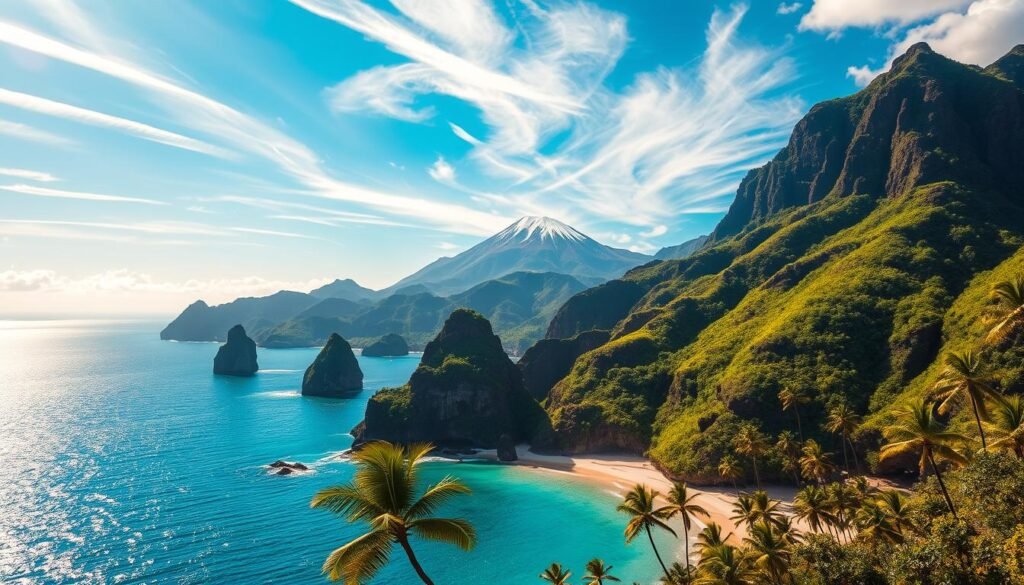Surprising fact: nearly half of the islands’ dramatic coastal cliffs and volcanic features formed within the last million years, giving the state a young, raw landscape few places on earth match.
I plan trips around contrasts: white and black sand, steam vents at calderas, rainforest trails, and silent lava fields. I pick an island for the mood I want—city energy in Waikiki or quiet calm on Lānaʻi.
I link iconic stops like the USS Arizona Memorial and Mauna Kea stargazing with hidden ridges and sea cliffs so a single journey feels rich, not rushed. I show how I chain islands into a seamless route focused on the best things I never skip and the small corners I return to.
For a deeper list of scenic lookouts and routes I use when planning, see a helpful roundup of top Hawaiian vistas at top Hawaiian viewpoints.
Key Takeaways
- I balance iconic sites with off-grid moments across multiple islands.
- I choose an island based on the kind of adventure I want.
- I connect destinations to avoid rush and maximize views.
- I focus on a few reliable experiences that deliver every time.
- Logistics are simple: pick a route, pick highlights, and enjoy.
How I Plan a First-Time Trip to the Hawaiian Islands
I start every trip by counting the hours I can truly spend exploring, not just traveling. That single step makes choosing an island much easier: with limited inter-island transport, one or two islands keeps days for doing, not commuting.best-time-to-visit-switzerland
Next I match the island to my mood. Oʻahu suits city energy and historic sites. The Big Island gives volcanoes, black sand beaches, and stargazing. Kauaʻi is for hiking and rugged coasts. Maui blends scenic drives and resort downtime. Molokaʻi and Lānaʻi offer quiet, off-grid calm.
My planning trip basics:
- I lock in how much time I have, then pick one home base per island.
- I book must-do things early — Pearl Harbor tickets, Haleakalā sunrise, or volcano access.
- I map nearby restaurants and food spots so dinner is easy after a long day.
- I factor rental car needs, sunset timing, and one lighter day after big outings.
I usually pair Oʻahu with the Big Island or Maui for clear contrast. I also leave gaps for a cafe stop or a sudden lookout that becomes the highlight of the day.
Best Places to Visit in Hawaii: My Island-by-Island Shortlist
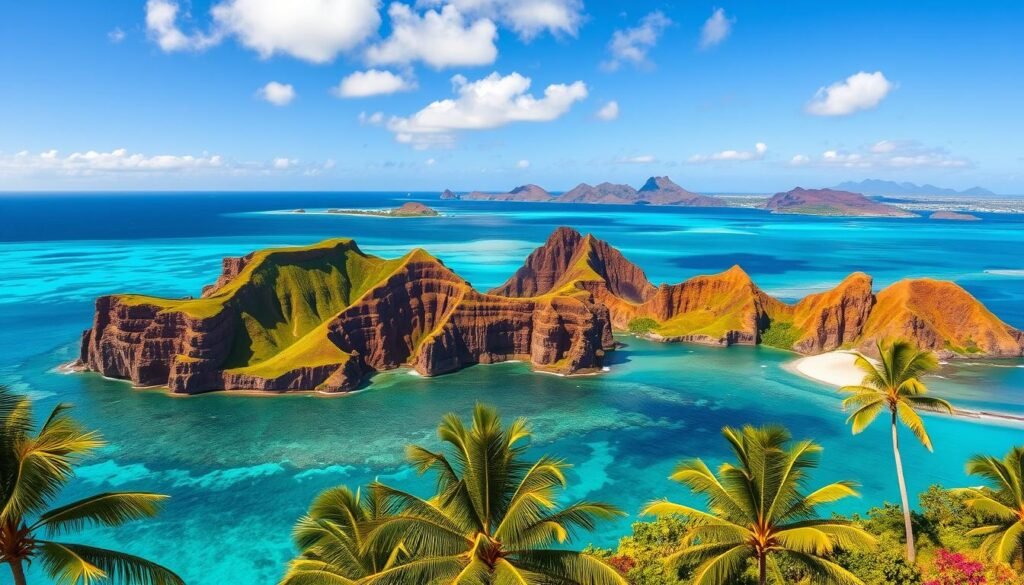
I build short, focused itineraries that pack big views into manageable days. Below are the anchors I choose on each island and the quick extras I add when time allows.things-to-do-in-duluth
Quick notes: I pick one main activity per day, then layer short viewpoints or a nearby café stop. I also book a couple of guided tours where access or local expertise matters.
| Island | Anchor activity | Add-ons | Why go |
|---|---|---|---|
| Oʻahu | Pearl Harbor morning | Lanikai Pillbox hike, North Shore sunset | History, coastal hikes, surf culture |
| Maui | Road to Hāna day | Haleakalā sunrise, Molokini snorkel | Waterfalls, crater views, marine life |
| Big Island | Volcanoes National Park | Punaluʻu black sand, Mauna Kea stargaze | Lava landscapes and night skies |
| Kauaʻi | Nāpali Coast choice | Waimea Canyon overlooks, waterfall hikes | Sheer coastlines and river valleys |
| Molokaʻi | Hālawa Valley guide | Long empty beaches, Pēpēʻōpae 4WD | Slow pace and cultural sites |
| Lānaʻi | Hulopoʻe Bay day | Keahiakawelo 4WD, Lānaʻi City stroll | Clear snorkeling and quiet roads |
If you want deeper Big Island ideas, check my roundup of Big Island activities for longer options and guided nightswims.
Oʻahu: Pearl Harbor History, North Shore Surf, and Big-City Energy
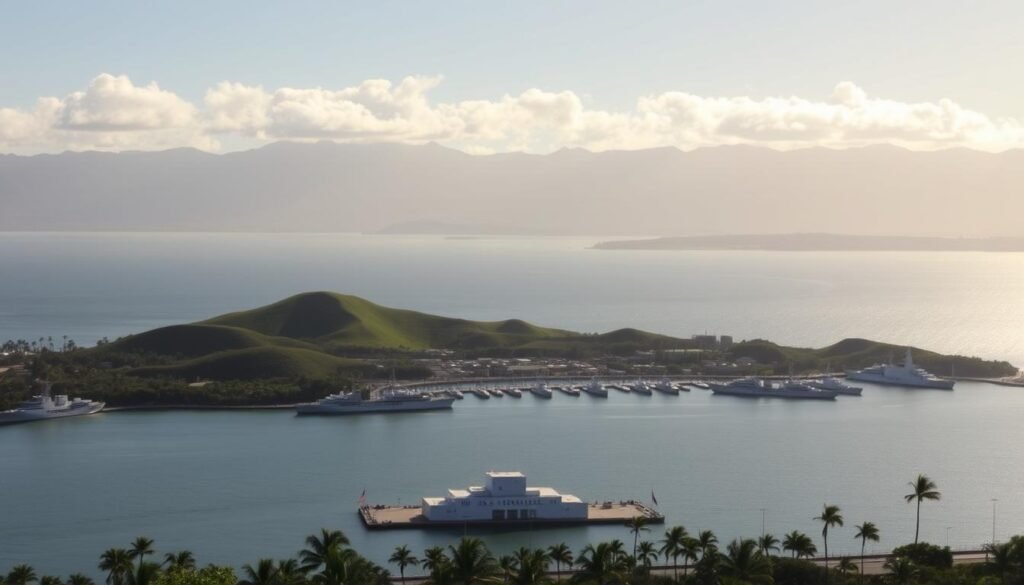
Oʻahu mixes solemn history, adrenaline surf breaks, and city nights into a single lively island rhythm. I split days so I can reflect, watch the waves, and still squeeze in skyline views without feeling rushed.
“I begin at the harbor, then chase waves and end with a sunset walk.”
Reflect at Pearl Harbor
I always start at pearl harbor. I pay my respects at the arizona memorial and peer down at the uss arizona site before touring the Battleship Missouri to grasp the full arc of history.things-to-do-in-charleston
Winter Waves on the North Shore
In winter, the north shore draws surf legends for events that define big-wave culture. I watch from a safe distance, camera ready, and soak up that world-class energy.
Honolulu, Waikiki, and Ridge Hikes
I walk Waikiki beach at sunrise, then hop up Diamond Head for city-and-ocean views. For short hikes, Lanikai Pillbox gives panoramic scenes, while Hanauma Bay is my go-to for a calm reef swim.
Where I Eat
I snack through local food, tiny restaurants, and a casual shave ice stop. Small breaks keep my days long and flexible so I can dodge crowds and enjoy every side of the island.
- Begin with reflection at the memorials.
- Reserve a north shore afternoon for surf watching.
- Balance hikes, beaches, and food stops across the island.
Maui: Road to Hāna, Haleakalā National Park, and Beach Time Done Right
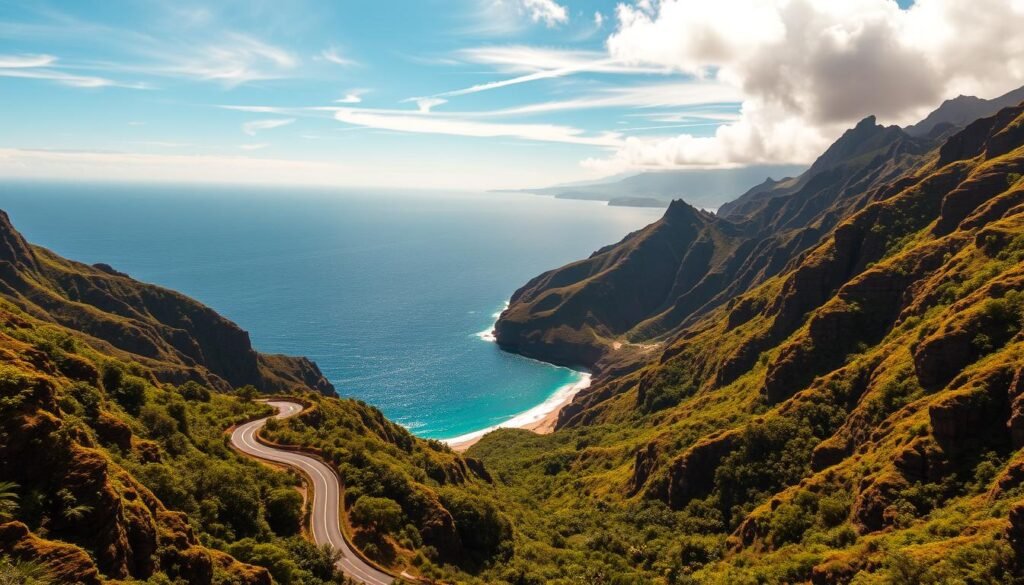
Maui folds dramatic coastlines and high ridges into days that feel both active and easy. I split my time between a summit sunrise and slow shoreline hours so each day breathes.things-to-do-in-key-largo
Haleakalā dawn and crater walks
I book a Haleakalā sunrise early and layer up—the summit tops out at 10,023 ft. After sunrise I add a short crater walk so the scale hits home.
Road to Hāna: waterfalls and a black-sand cove
On the Road to Hāna I time stops for waterfalls and the black sand at Waiʻānapanapa. Reservations are required there, so I plan that stop ahead and leave room for photo pullouts.
Beaches, snorkeling, and a helicopter splurge
I rotate between golden stretches and a nearby red or black sand spot so my photos feel varied. Molokini sits about 2.5 miles offshore; I pick tours that give plenty of water time for sea life and clear views.
In winter I keep an afternoon open for whale watching. When weather lets me, a helicopter loop around Molokaʻi’s sea cliffs is a splurge I never forget.You can learn more about best-time-to-visit-greece
“Book the sunrise, savor the road, and leave space for the unexpected.”
Island of Hawaiʻi (Big Island): Volcanoes, Lava Landscapes, and Stargazing
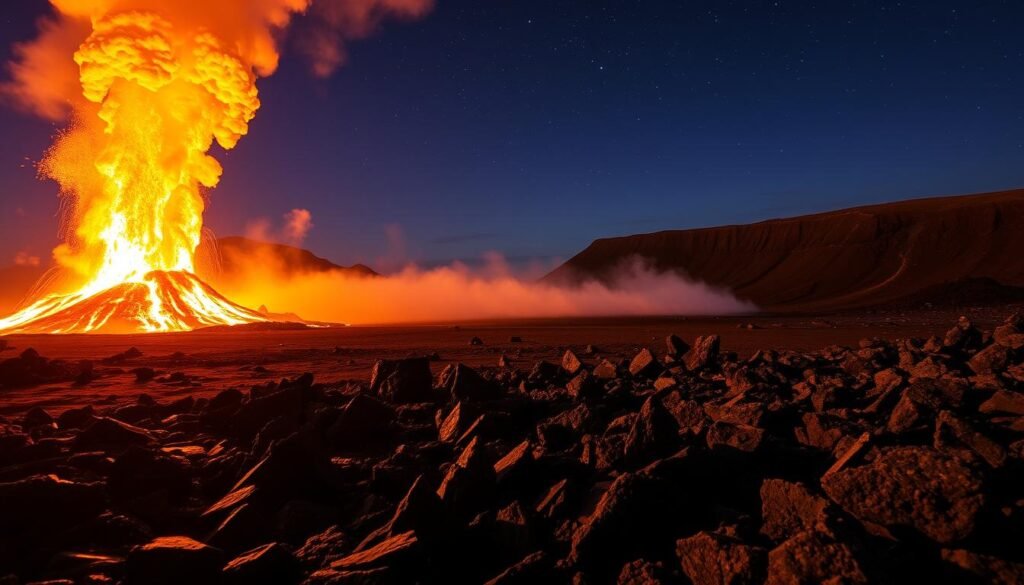
The Big Island unfolds like a map of extremes: steaming calderas, black shores, and nights so clear the Milky Way feels close enough to touch.
Hawaiʻi Volcanoes National Park deserves a full day. I walk lava tubes, scan steam vents, and check current conditions before approaching viewpoints. The park holds Kīlauea and Mauna Loa, and those active systems shape the island’s raw edges.things-to-do-in-long-beach-ca
Mauna Kea above the clouds
I plan a sunset-and-stars outing to mauna kea, packing layers and letting elevation set the pace. Above the clouds, the night sky is one of the world’s clearest shows.
Beaches born of lava
Punaluʻu Black Sand and the rare Papakōlea green crescent are shoreline moments I time for early light and calm winds. Turtles often rest at Punaluʻu, so I move quietly and keep distance.
Kona Coast vibes and wide-open roads
The Kona coast mixes coffee farms, manta ray night snorkel tours, and golden sunsets. I break long drives into scenic segments—rainforest, ash desert, then coastline—so each day feels varied and relaxed.
“I leave a flexible slot for last-minute trips around the park — conditions can change fast.”
For current viewing notes and safe lava outlooks, I also check a local guide on lava viewing before I go.
Kauaʻi: Nāpali Coast Drama, Waimea Canyon, and Waterfall Hikes
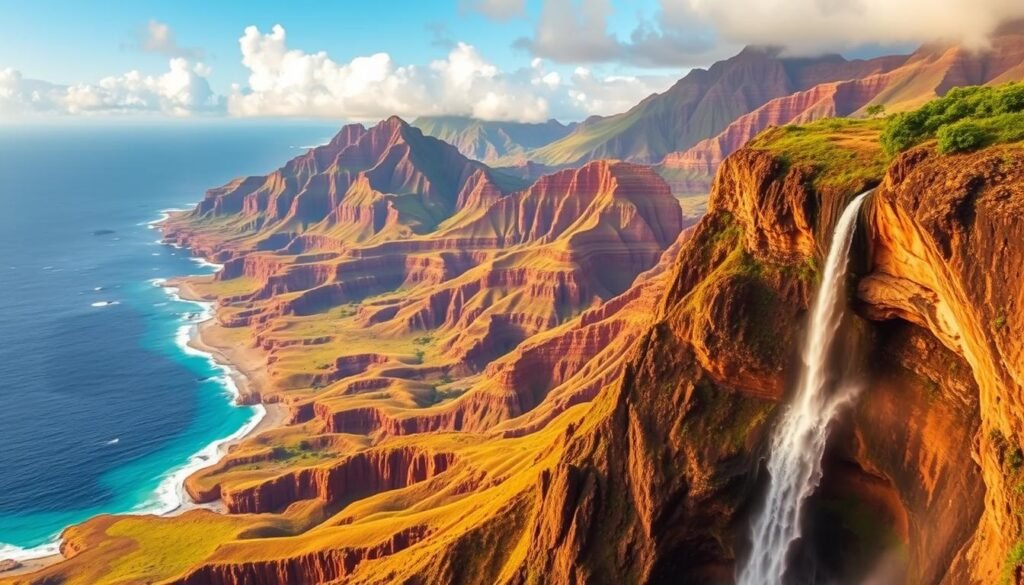
Kauaʻi feels like a wild, green theater where cliffs, gullies, and waterfalls take center stage. I pick an angle first—trail, boat, or helicopter—because weather and permits shape how much of the coast I can see.things-to-do-in-budapest
Nāpali access by trail, boat, or helicopter
The Kalalau Trail runs 22 miles round trip, but even short sections give towering cliffs and ocean views. If miles and permits aren’t on my side, I book a boat or a chopper for a different perspective.
Waimea Canyon and Kōkeʻe overlooks
Waimea Canyon is often called the Grand Canyon of the Pacific. I balance roadside overlooks with a moderate Kōkeʻe hike so the vast landscape feels both broad and detailed.
Chasing Wailua, ‘Ōpaeka‘a, and Hanakāpīʻai
I stack waterfalls: easy roadside shots first, then a longer trail for Hanakāpīʻai when the forecast looks steady. Trails can get slick, so I bring traction and layers.You can learn more about best-places-to-visit-in-europe
“Choose your Nāpali angle early, and leave afternoons for beautiful beaches or a quiet café.”
- I watch miles on Kalalau sections and pack for quick pivots.
- I prioritize sunrise or late light for the best canyon views.
Molokaʻi & Lānaʻi: Quiet Adventures, Tallest Sea Cliffs, and Laid-Back Luxury
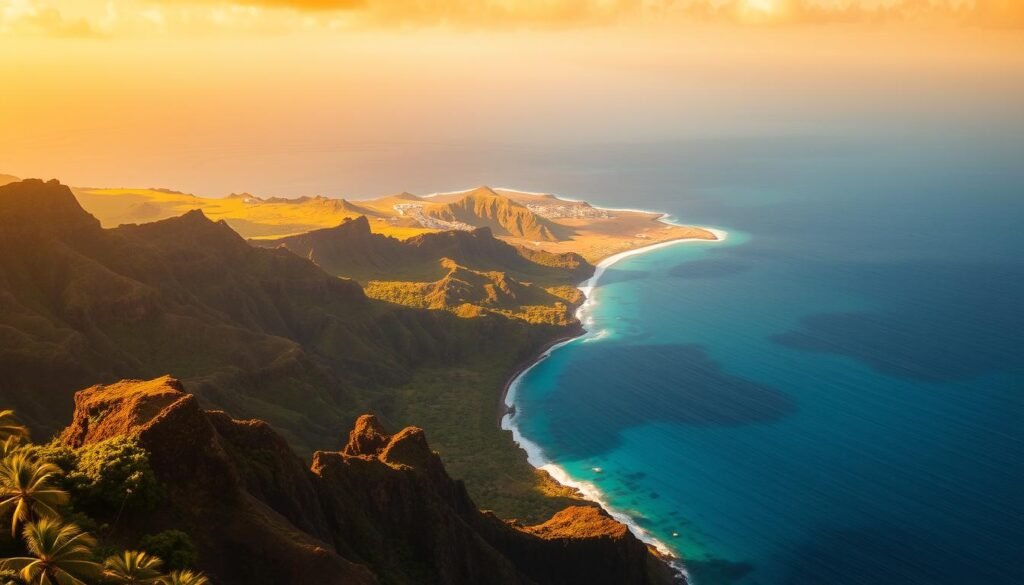
I save a couple of easy days for Molokaʻi and Lānaʻi where cliffs and calm beaches set the pace.
Molokaʻi asks for patience. I book a Hālawa Valley hike with local guides because the trail crosses private land and the story there deserves respect.
I pack a 4WD for Pēpēʻōpae Bog. The drive rewards me with native plants and sweeping cliff views few people see.things-to-do-in-gainesville-fl
Molokaʻi notes
- I plan Hālawa with a guided tour, then unwind on a long, quiet beach where turtles are common.
- Kalaupapa’s history is sobering; I give it time and silence.
Lānaʻi highlights
Hulopoʻe Bay makes a great half-day for snorkeling and calm water. Later I take a 4WD route toward Keahiakawelo for late light across the sea.
I enjoy Shipwreck Beach from the bluff and a slow coffee in Lānaʻi City before I leave.
“One beach, one lookout, one simple meal — that’s my way here.”
| Island | Main activity | Access note | Suggested stay |
|---|---|---|---|
| Molokaʻi | Hālawa Valley hike & beach walk | Guided tour required | 1–2 days |
| Molokaʻi | Pēpēʻōpae Bog viewpoint | 4WD, early start advised | Half day |
| Lānaʻi | Hulopoʻe Bay snorkeling & Keahiakawelo | Beach swim and 4WD road | 1 day |
| Lānaʻi | Shipwreck Beach view & Lānaʻi City | Easy road, no water entry | Half day |
Epic Hawaii Experiences I Never Skip
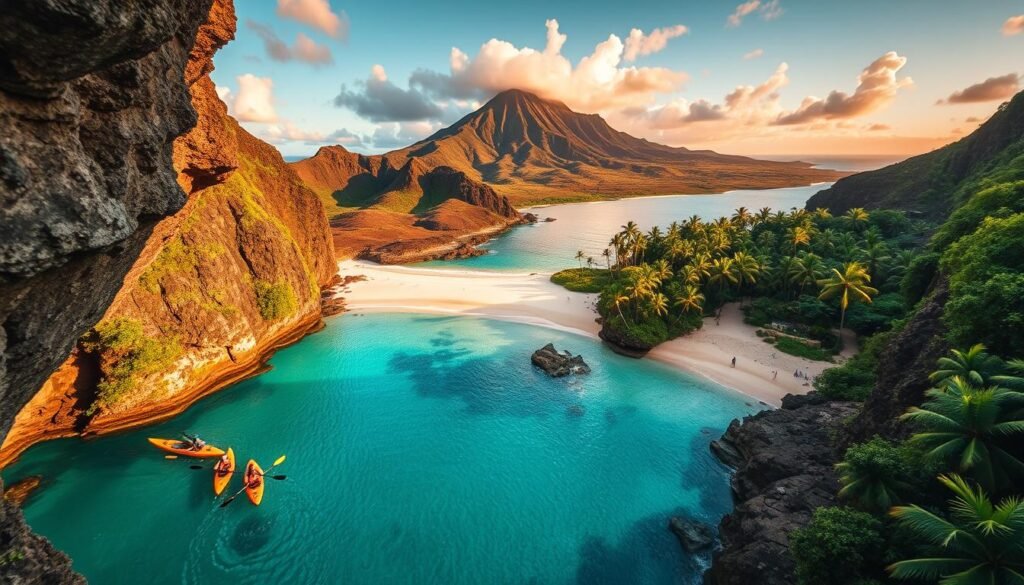
Some experiences lift a trip from good to unforgettable, and I always carve time for those. I pick one bold anchor each day, then let smaller moments fill the hours.things-to-do-in-boise-idaho
Helicopter flights over cliffs, coasts, and craters
A helicopter loop on a clear morning shows Molokaʻi’s towering sea cliffs, volcanic craters, and sweeping coastlines in one sweep. From above, miles of coastline and lava fields read like a map.
Iconic hikes with big views
I keep time for short, sharp trails. Diamond Head and Lanikai Pillbox give city-and-sea views without a full day lost. When I can, I add a crater rim walk for scale.
Beach days and surf watching
Beach hours are sacred. I split time between Waikiki and the north shore and watch surf sets roll in. People gather at pullouts for waves, photos, and golden light.
Eat like a local
I snack on poke, warm ramen, bright shave ice, and a mid-morning Kona coffee. Great food and small restaurants often become the memory anchors of a day.
Tours that add wow
Some tours are worth every minute—manta ray night snorkels on the Big Island, boat trips along dramatic cliffs, and cultural stops like Pearl Harbor’s Arizona Memorial and the USS Arizona site.
“One anchor a day keeps the trip feeling full, not frantic.”
- I leave room to pivot — lava viewing at Volcanoes National Park or a clear Mauna Kea night can change plans.
- I watch for changing sand and landscape colors; small walks often reveal new views.
Conclusion
My favorite trips leave space for a sudden trail, a last-minute helicopter seat, or a slow beach hour. ,
I choose the things I care about, pick the islands that match, and give myself time to breathe. If lava and stars call, the big island and its national park are hard to beat. If scenic drives and golden sand matter, Maui often fits one best.
Kauaʻi answers hiking and canyon cravings, Oʻahu mixes culture and nightlife, and Molokaʻi or Lānaʻi reset my pace with quiet bays. I book a key tour, then leave room for short trails and perfect sunset hours.
When you’re ready, pick your island, lock a few anchors, and let the trip unfold. Close with a slow sunset and one final local bite — that’s my ritual for a day well spent.


